Please use the following link to download the November 9, 2019 issue of the syəcəb:

syəcəb
Please use the following link to download the November 9, 2019 issue of the syəcəb:

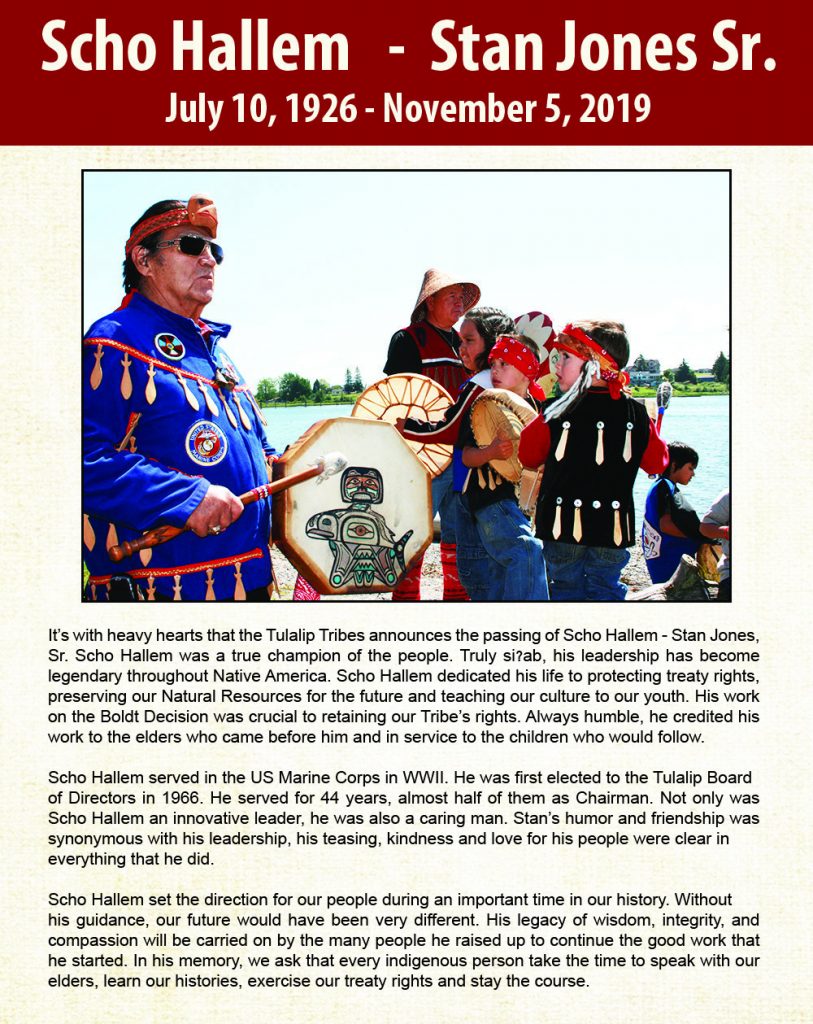
Funeral services:
Monday 5:30 p.m. at the Tulalip Resort Orca Ball Room
Tuesday 10:00 a.m. at the Tulalip Resort, Orca Ball Room
Tuesday, Burial at Mission Beach Cemetery and dinner to follow at the Tulalip Gym.
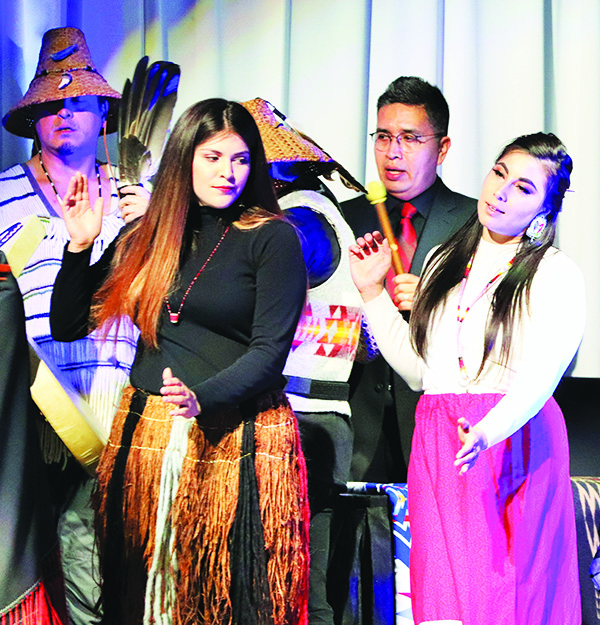
By Micheal Rios, Tulalip News
Potlatch Fund is a Native-led nonprofit that provides grants and leadership development in tribal communities throughout Washington, Oregon, Idaho and Montana. The Fund’s driving mission is to expand philanthropy within Northwest tribal nations by inspiring and building upon the tradition of giving. From potlachs to powwows, building community and sharing wealth has always been a part of Native peoples’ way of life.
On November 2, the Potlatch Fund held its highly anticipated annual fundraising gala. With venue location and theme changing every year, the one constant the gala promises is attendees will be inspired and given ample opportunity to show their generous side. This year the location was Little Creek Casino Resort and the theme: ‘Spirit of Reciprocity’.
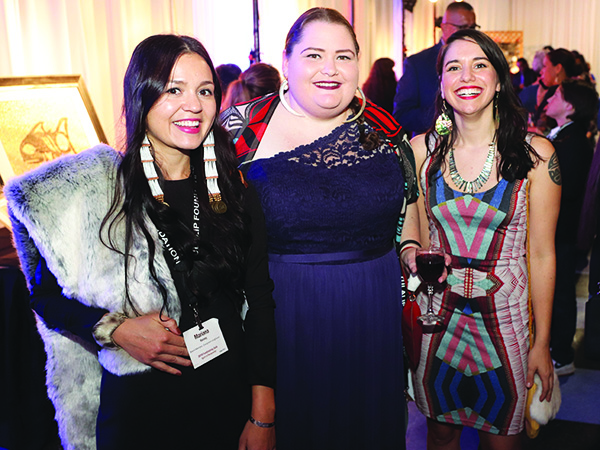
“This gala brings together people of many different tribes, from many different communities, from many different organizations, and unites us in the common goal to raise money to help us meet the needs of Northwest Indian Country,” said Dr. Charlotte Coté, Potlach Fund board president. “Our theme ‘Spirit of Reciprocity’ really captures the essence of our organization’s mission to expand philanthropy for and among tribal communities, while empowering community leaders with the tools they need to succeed.
“We have gathered here in the spirit of the potlatch tradition with the sharing of song, dance, art, and of course delicious food,” Dr. Coté continued. “The support we’re so thankful to receive allows us to keep alive the spirit of reciprocity. I raise my hands to everyone who joins our Potlatch Fund canoe and helps us paddle to our fundraising goals.”
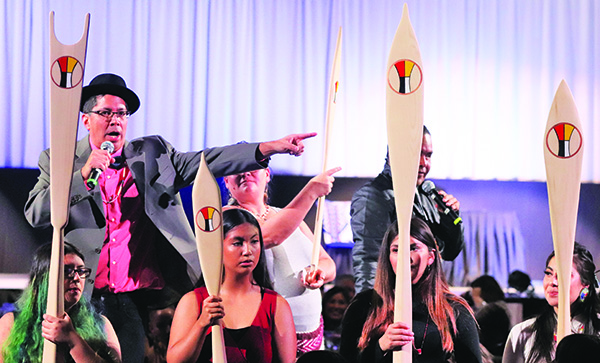
Since 2005, Potlatch Fund has re-granted over $4.5 million in the support of tribes, tribal nonprofits, Native-led nonprofits, Native artists, and Native initiatives in their four-state service area. Through a focus on youth development, community building, language preservation, education and Native arts, they are building a richer future for all that they serve.
The Potlatch Fund’s annual gala is their major fundraising event and brings together people from a variety of neighboring tribes, organizations, corporations and communities. Close to 20 Washington State tribes were listed as event sponsors, including the Tulalip Tribes listed as a Raven-level sponsor.
At the gala, Native community impact makers are given a chance to share their plans for the future and learn how other like-minded individuals and groups are striving to make a positive difference for the benefit of Indian Country. This is an invaluable benefit for up-and-coming leaders and organizations who can sometimes struggle to get their message broadcast to larger audiences.
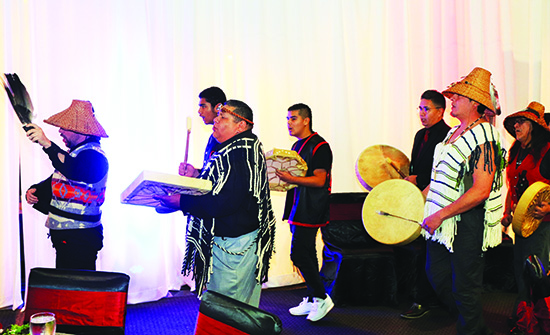
“At Potlatch Fund, we recognize the importance of bringing people together to share our stories and experiences,” added Dr. Coté. “Our intent is to generate deeper connections and conversation among Native professionals and our extended community. All are welcome to attend and build relationships with our Native communities.”
A dynamic and truly benevolent event that brought together tribal leadership, representatives and impact makers from all across the Pacific Northwest, the fundraising gala also had additional benefits for guests. In a setting befitting those who strive to make the world a better place than they found it, the mostly Native gathering took in the sights of Squaxin Island Tribe drummers and dancers, heard the enchanting violin sounds of Lummi musician Swil Kanim, and perused a silent auction filled with unique Native art.
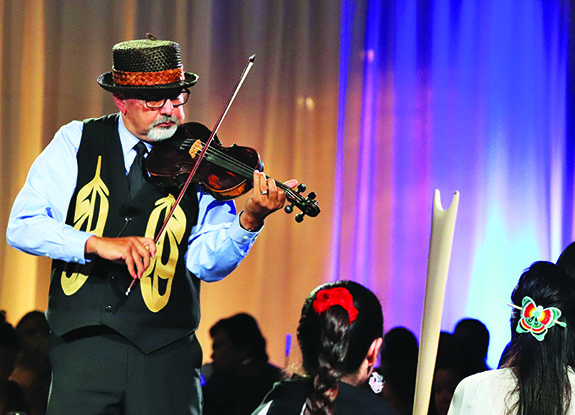
“Potlatch Gala is the most fun event of the year,” shared Suquamish Foundation Director, Robin Little Wing Sigo. “Not only does it raise money, but it raises spirits, energy and excitement. Everyone gets to get dressed up and connect with people they may only see once or twice a year. Also, so many incredible artists donate their artwork for the silent auction that gives us a good opportunity to purchase wonderful Native bling.”
“We lovingly call it ‘Native Prom’ because it’s one of the last gatherings of the year and we all get dressed up to celebrate being Native,” added Colleen Chalmers, program manager at Chief Seattle Club. “There is representation from so many different tribes yet we’re here as an Indigenous community proving we are still here and we are thriving.”
The ‘Spirit of Reciprocity’ gala provided the opportunity to share culture through song and dance performances, to support and celebrate Native art and artists, and to assist Potlatch Fund with its fundraising efforts as it continues to undertake important work throughout Northwest Indian Country. The evening centered on generosity and was a success as pre- and post-dinner networking receptions brought people together to create future impact opportunities, while close to $60,000 was fundraised that will ultimately go to where it’s needed most, Native communities.
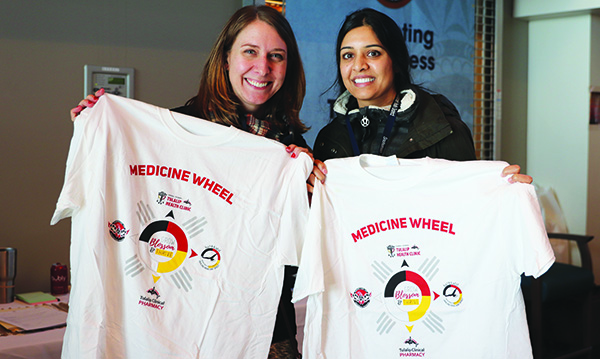
By Kalvin Valdillez, Tulalip News
A delightful aroma filled the air around the Karen I. Fryberg Health Clinic on November 5. Near the clinic’s entrance was Indigenous Chef Britt Reed, sizzling up a stir-fry mixture of cabbage, onion, celery and chicken. The chef displayed her outdoor culinary skills over a propane flame, and the large wok of fried veggies and protein garnered plenty of interest from clinic patients and those living with Type 1 or Type 2 diabetes in attendance of the Diabetes Care and Prevention program’s yearly Diabetes Day.
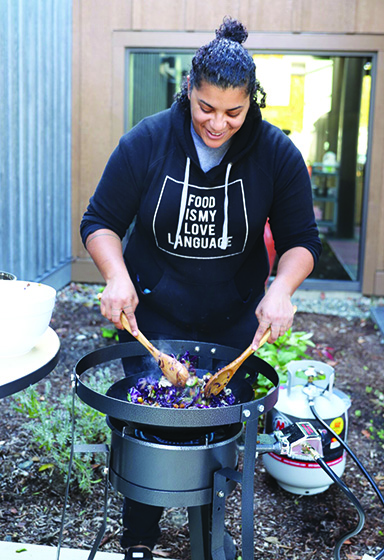
Occurring during National Diabetes Month, the event aims to educate and raise awareness about diabetes, while having a good time with the local community, through healthy tips, resources and support to those diagnosed with the disease.
“We like to take this day to spend some time with our patients, and maybe meet some new patients, to see how they are doing because it’s the end of the year,” explained Miguel Arteaga, Tulalip Health Clinic RN and Diabetes Educator. “Diabetes is exploding across the world, it’s always been a problem for the U.S. and particularly with minority people. At Tulalip, we want to present the community with the best information there is to help prevent diabetes.”
The six-hour event allowed attendees to get acquainted with fellow diabetics and build a strong sense of community as well as hear a number of presentations by local organizations and businesses. Event goers were served two meals and an assortment of tasty snacks throughout the day, learned of new foods and recipes and how to prepare well-balanced meals to manage their diabetes more efficiently.
“65% of patients with prediabetes can prevent the onset or delay diabetes from occurring by simply losing 7% of their body fat, just by making changes in their food choices,” said Diabetes Program Coordinator, Veronica ‘Roni’ Leahy. “Instead of ‘changing’, we talk more about shifting. Shifting from one food to another, something that is of equal value, is still tasty to you, but is a healthier version of it. We gave away bags of food to the people who came to watch Britt’s cooking demonstration. I think that’s a key component, bringing healthy foods to tribal homes that they can cook themselves. Eating healthy can be fun and simple.”
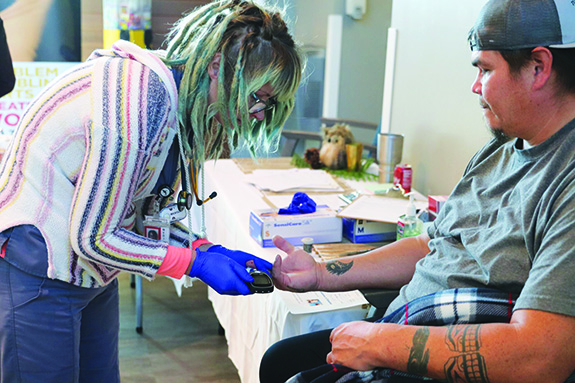
This year, the Diabetes Prevention and Care team put a little extra emphasis on prevention. According to the Centers for Disease Control and Prevention (CDC), diabetes is still on the rise throughout reservations nationwide. Their research has found that over 16% of the Indigenous population has been diagnosed with diabetes, nearly double the amount of the white American population. Meaning almost one in every six Native peoples are living with that diagnosis. These staggering statistics prompted the Tulalip Wisdom Warriors to ask the Diabetes program to focus on providing prevention education for the younger generations.
“I’m a Wisdom Warrior and having diabetes, naturally I want to learn as much as I can to take care of myself,” said Tribal Elder, Hermalee Coando. “Unfortunately, a lot of our tribal people have excessive weight and a lot of times we are fed, and often choose to eat, stuff that’s not good for us. There’s too many sweets available. The more education we have about what we drink and consume and how it damages our body, the more we know how we can prevent it. And the younger we start teaching the youth, the better. Our kids should continue to listen to the elders about our foods and take the wisdom we have to utilize it in your daily life. Don’t glorify candy, it’s better in the long run to have something healthy for you.”
The everyday bustle can often weigh us down and at times it is much easier to grab a quick and convenient bite at the end of a long day. But taking a little extra time to meal prep at the beginning of a busy week can assist diabetics, and even non-diabetics, in staying true to their diet, help regulate their blood sugar levels, and reach and maintain their personal goals.

Another equally important area the on-the-go diabetic must consider is self-care, which includes exercise and mindful practices such as meditation, yoga and tai-chi. For Diabetes Day, Roni led two seated tai-chi sessions, which is proven to help promote blood flow, muscular strength, flexibility, heart and lung function, and also reduce stress. In fact, the art of tai-chi is a highly recommended exercise for all diabetics. Because Natives are at such a heightened risk to be diagnosed with the disease, it’s important to find a way to incorporate these practices into daily routines.
“I’m a young Tribal member and was diagnosed with diabetes a couple years ago,” said Mike Pablo. “I was always healthy and active when I was younger. And what do you know, I’m a Type 2 diabetic. I believe awareness needs to be raised and people need to know what’s going on within their bodies because Native Americans are at a higher risk. There was a lot of good information here today. I came in for an appointment with the chiropractor and because I have Type 2 diabetes, I thought this looked interesting and checked it out to see what they have to offer. There were a lot of new recipes I picked up and am excited to use at home.”
Along with education and resources, the program also offered free blood glucose checks as well as tuberculous screenings. The World Health Organization states that approximately 15% of TB cases can be linked to complications from diabetes, as diabetes triples the likelihood of a someone developing TB.
“I didn’t realize diabetes was connected to so many other health complications,” admits Type 2 Diabetic, Debbie Jackson. “I came for a dental cleaning and the clinic encouraged me to check out Diabetes Day. I very much liked the cooking I watched Britt do. I learned about different spices I can use in my cooking instead of sugar and salt. It was a very good day, the food was excellent and the people were helpful.”
Diabetes Day drew close to a hundred participants throughout the event. People left with not only reusable totes filled with gifts and goodies, but also a better understanding of diabetes and how to properly care for, prevent and manage the disease.
“We want to strengthen, teach and encourage the people to overcome the setbacks and drawbacks of diabetes and make sure they have a really good quality of life,” Miguel expressed. “We care about them as individuals and want to see them have a better life. There’s so much we can do to empower people to learn how to manage their diabetes.”
The Diabetes Care and Prevention program has a few more events planned to close out 2019, including a Thanksgiving holiday dinner, a Seahawks game night and the annual Christmas powwow.
“For 2020, we’re going to start the National Diabetes Prevention program,” Roni said. “Our plan is to go about it in a way that’s similar to our past workshops. We want to incorporate herbal teachings with cooking, helping people make food shifts and monitor their weight loss and increase exercise. The patient to patient interactions is where we really see a lot of growth with our people, helping and supporting each other. Because they experienced what a newly diagnosed person is going through, they can be an inspiration to them so those people don’t feel like they have to walk through that alone.”
For more information, please contact the Diabetes Care and Prevention program at (360) 716-5641.

Tulalip, Washington — Tulalip Resort Casino chefs are excited to whip up their newest filbert-filled creations for their dining guests. From breakfast and salads to seafood and tempting desserts, these seasoned chefs have rounded up some creative hazel-nutty recipes. Tulalip’s third annual “Hazelnut Holidays” will run from November 1 through December 1, 2019.
Local hazelnuts from Hazel Blue Acres will be featured throughout the Resort’s restaurants. What makes Hazel Blue Acres hazelnuts so special? These nuts originate at a local family farm in Silvana, Washington, near the Stillaguamish River. Tulalip’s commitment to curating top local ingredients in all of their dishes is highlighted with their partnership with Hazel Blue Acres.
“Hazelnuts are not just for dessert,” shares Executive Chef Perry Mascitti. “Hazelnuts and chocolate are a match made in heaven and their rich, nutty flavor can turn any dessert into a masterpiece. Roasted hazelnuts (chopped or whole) can impart a buttery savoriness to everything from salads to meat dishes, and can transform an otherwise simple dish into a satisfying, hearty plate. We can’t wait to share this year’s Hazelnut Holidays with you!”
The Tulalip chef team invites all Resort guests to enjoy the following hazelnut-laced selections during November’s Hazelnut Holidays.
Blackfish Wild Salmon Grill and Bar’s Chef David Buchanan loves cooking with hazelnuts because they add a sweet, nutty flavor to his Hazelnut Pesto Sea Bass. The Sea Bass is encrusted with the hazelnut pesto, served with a Havarti polenta, and autumn succotash of corn, roast butternut squash, asparagus, zucchini and red onion. And for the finale to dinner, guests can enjoy Pastry Chef Nikol Nakamura’s Sutell Stuffed Beignets. They are stuffed with Nutella hazelnut spread and served with praline ice cream, which should not be missed.
Is breakfast your favorite meal of the day? If so, then head over to Cedars Cafe, where Chef Brent Clarkson will be preparing his Cedar’s Café Grilled Hazelnut Coque Madame. Served on a grilled hazelnut crusted egg bread, layered with Havarti cheese, prosciutto, ham and two cook-to-order eggs, topped with the Chef’s Sauce Mornay. This hazelnut special will be offered seven days a week during November from 6 am to 4 pm. To fulfill your sweet tooth, indulge in their Chocolate and Hazelnut Pudding served with Frangelico cream, toasted hazelnuts and fresh raspberries. The perfect way to start any morning!
Join Chef Jeremy Taisey for Tula Bene Pastaria + Chophouse’s house-made Garganelle pasta served with braised pork, toasted hazelnut ragu, sun-dried tomatoes, rosemary, parmesan cheese and pickled peaches. And to end the meal with a slice of pure sweetness, try Pastry Chef Nikol Nakamura’s Gianduja Tart made with creamy mascarpone and a rich, deep chocolate hazelnut filling.
For a quick bite on-the-go, make a stop at either the Carvery or theHotel Espresso fortheir Toasted Hazelnut Chicken Salad. The salad will be served with a roasted chicken breast, toasted Hazel Blue Acres hazelnuts, and red grapes on a bed of crisp Bibb lettuce.
As part of this year’s Hazelnut Holidays, Chef Lil at Eagles Buffet will be sharing her signature Roast Pork Tenderloin. It will be served with a house-made mustard hazelnut sauce, which is part of the daily buffet offerings. For menu information and pricing, visit here.
At The Draft Sports Bar and Grill, it’s all about the Hazelnut Chicken Bites. Chef Susan is serving these golden brown hazelnut crusted chicken bites with their house-made bleu queso dipping sauce.
Tulalip’s Blazing Paddles Stone Fired Pizza and Spirits are showcasing their Hazelnut Fig and Pear Pizza this November: a tempting pizza layered with fig jam, arugula, red and Bartlett pears, brie cheese, prosciutto and topped with hazelnuts.
Are you craving a dessert pizza? Order Blazing Paddles Hazelnut Cinnalicious made with cinnamon streusel, green apples and drizzled with a caramel sauce.
The Tulalip culinary team extends an invitation for everyone to come and experience their “Hazelnut Holidays” for this limited engagement. For more information, visit tulalipcasino.com.
Please use the following link to download the November 2, 2019 issue of the syəcəb:
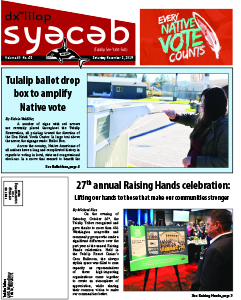
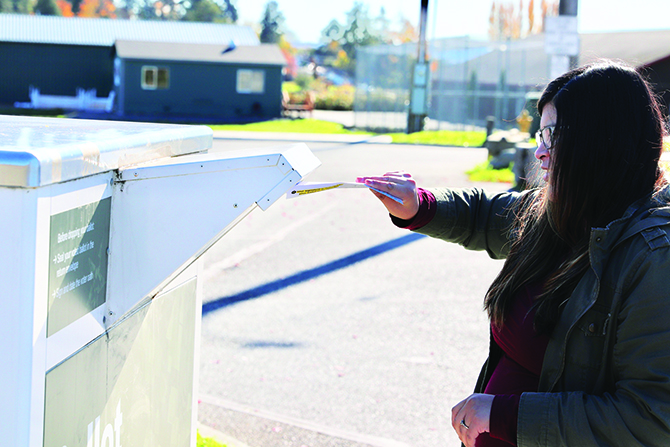
By Kalvin Valdillez, Tulalip News
A number of signs with red arrows are currently placed throughout the Tulalip Reservation, all pointing toward the direction of the Don Hatch Youth Center. In large text above the arrow, the signage reads: Ballot Box.
Across the country, Native Americans of all nations have a long and complicated history in regards to voting in local, state and congressional elections. In a move that seemed to benefit the assimilation agenda, the United States granted Indigenous Peoples U.S. citizenship in the 1920’s. This, however, did not allow Native people the right to vote. In fact, the government left it up to each individual state to determine if tribal members could cast a vote come Election Day.
For approximately forty years, the tribes fought for the right to vote. With Utah guaranteeing voting rights in 1962, Natives could legally participate in many, but not all, voting events within their cities, counties, states and country. But, the fight was far from over.
From the sixties to present day, Native communities often face a number of obstacles during voting season. Making national headlines in the fall of 2018, North Dakota received a U.S. Supreme Court ruling that allowed the state to enforce a voter ID requirement upon its citizens in order to register to vote. The voter ID requirement asks voters to show an identification card with a residential address at polling stations, noting that tribal status cards are not an acceptable form of ID. Being that most reservations adhere to the P.O. box system and generally don’t have physical street addresses, thousands of voices were silenced in result of the ruling.
Another barrier Native voters have to overcome is distance. More often than not, polling places and ballot boxes are located miles away off-reservation.
Unfortunately, due to the many hoops Native people have to jump through in order to have a say, a lot of them feel discouraged from voting, resulting in record low turnouts and thousands of unfilled ballot choices each year.
In a Nation that appears to be deliberately suppressing the Native vote, Washington State passed Senate Bill (SB) 5079, also known as the Native American Voting Rights act, this past February.
“Voter participation is not a partisan issue; it is the foundation of our democratic system and must be protected by all sides,” stated Senator John McCoy, Prime Sponsor of SB 5079 and Tulalip tribal member, on the Senate floor.
The bill passed with a 34-13 vote and addresses Native American voter suppression by allowing voters to register online with a tribal ID, use a tribally designated building as a mailing or residential address, as well as place one ballot box on each reservation, at the tribe’s request. The bill was officially signed into law by Washington State Governor Jay Inslee on March 14.
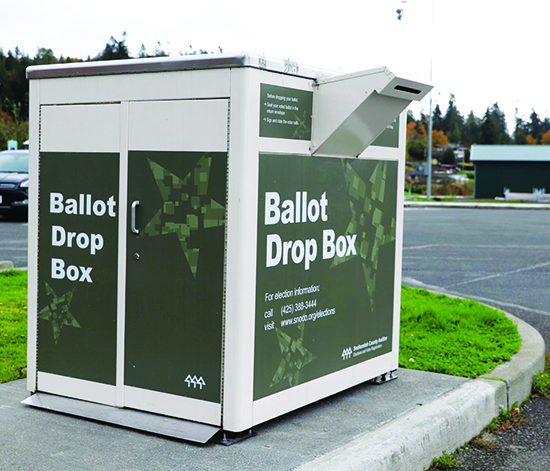
Just in time for Election Day, a new ballot box was recently established inside the parking lot of the Don Hatch Youth Center. An approved amendment to the bill states the location of the drop box must be accessible by way of road to the county auditor. The location must also be central and accessible to all tribal members.
“Historically, the Tulalip gym was a voting place for many years,” said Democratic National Committee Native American Political Director and Tulalip tribal member, Theresa Sheldon. “The Tulalip community would come to the gym every year to cast their vote by machines. Once we moved to mail-in elections, Tulalip lost our voting place. Since then, we have been aggressively requesting from Snohomish County to be an official ballot drop off location. This didn’t happen until Senator John McCoy passed a bill in the State legislature stating a ballot box must be located on every reservation to ensure access to voting.”
A few days after Governor Inslee signed the Native American Voting Rights act into law, he also signed a universal voter registration law, which automatically registers Washington State citizens, who are obtaining an ID card or driver’s license, to vote. This law of course eliminates the issue of utilizing your tribal status card as a form of identification when registering to vote.
“I’m very thankful for any law that makes voting more accessible,” expresses Theresa. “We all live such busy lives so having a designated place to drop your ballot off, any time of day, is very much appreciated. Washington State’s new voting laws also make it so everyone over the age of 18 years old is automatically registered to vote. They use your address from your driver’s license.
If you need to update your address or did not receive your ballot, please contact Snohomish County auditor’s office if you live within Snohomish County. Their phone number is (425) 388-3693, they have an actual human being who answers the phone and is very helpful.
If you misplace your ballot, you can always go to the County office to vote in person. Also, if you would like help with your ballot and the massive amounts of issues, here is a great resource, https://progressivevotersguide.com/Washington/.”
The new ballot box is accessible 24 hours a day, until 8:00 p.m. on November 5, Election Day.
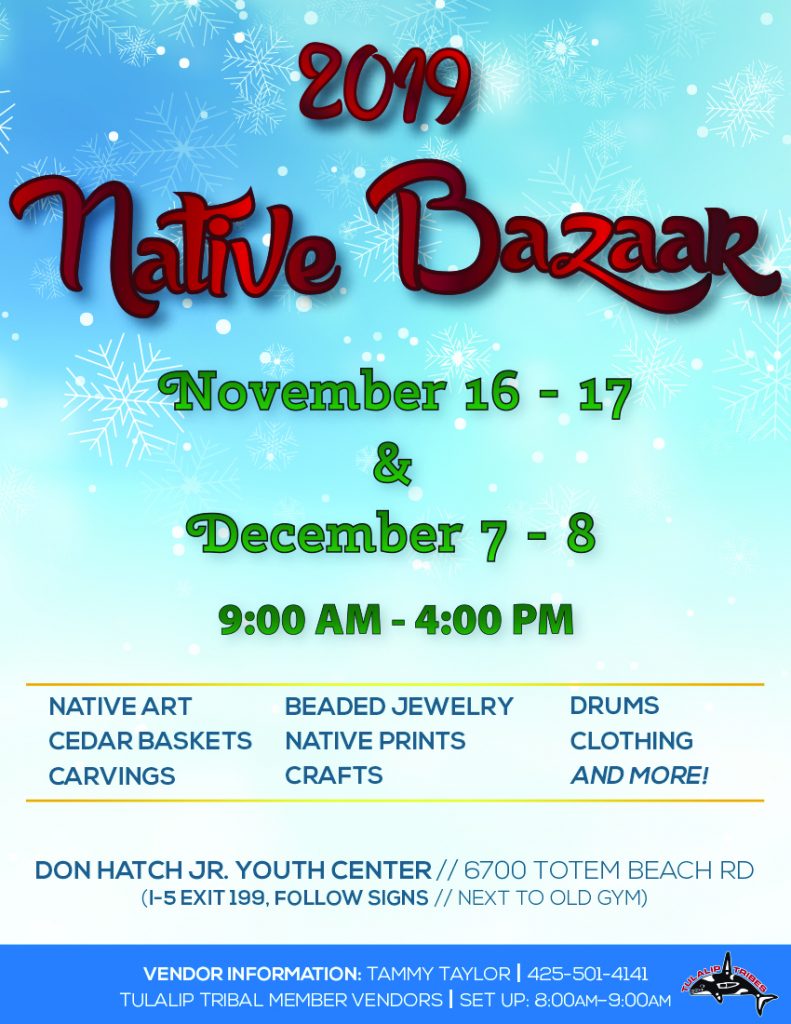
Response Times Will Improve from 18 to Six Minutes on Average
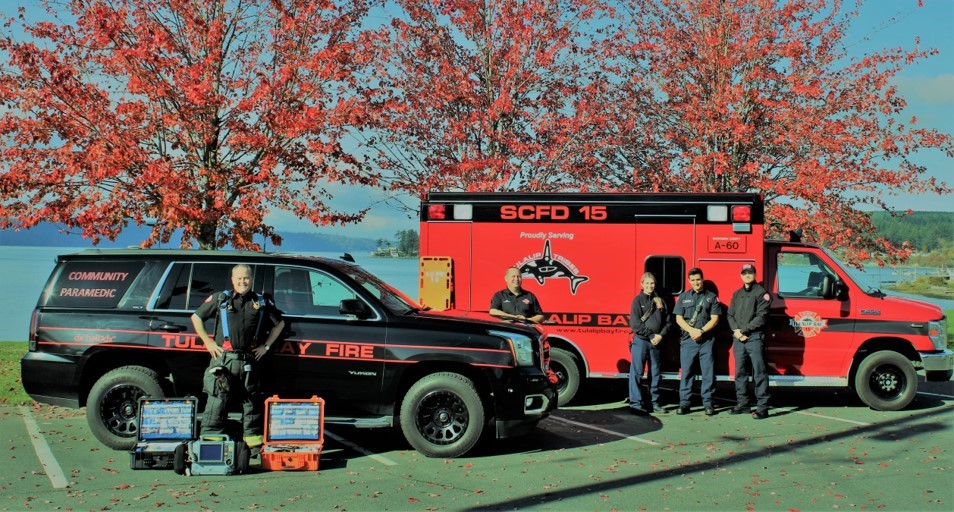
[Tulalip, Wash.] – The Tulalip Bay Fire Department (also known as Snohomish County Fire District 15) received a license to provide Advanced Life Support care from the State of Washington. This is the first time such care will be provided from sovereign lands, and will benefit all taxpayers in the district.
Previously, patients had to wait 18-23 minutes for a Paramedic to arrive. With the license, the Fire Department will employ full-time Paramedics to provide these services reducing the average response time to six minutes.
“This life-saving program is made possible thanks to the generosity of the Tulalip Tribes,” said Fire Chief Ryan Shaughnessy. “We could not provide this level of service for all residents without tribal support, and we are grateful.”
The Fire Department has a funding agreement with the Tulalip Tribes that makes this possible. In it, the Tulalips agree to pay the same amount in taxes as non-tribal members who own property in the Fire Department’s service area.
Prior to receiving its license, the Fire Department provided Basic Life Support, or BLS. ALS stands for Advanced Life Support, and is the highest level of emergency medical care that an agency can provide. It includes medication therapy for stroke and cardiac events, advanced respiratory care, and seizure control for patients.
“We have had a Paramedic response to our fire district since the late 1960s,” said Deputy Chief Jim Reinhardt who oversaw the license application. “We are grateful to the neighboring agencies who provided this type of mutual aid in the past.”
There are two licenses that an agency can apply for in Washington State. One is for ALS Aid and the other is for ALS Transport. The Fire District secured its ALS Aid license, and will continue to rely on neighboring jurisdictions to transport patients to area hospitals. These partners include Arlington, Everett, the Marysville Regional Fire Authority, and the North County Regional Fire Authority.
Deputy Chief Reinhardt is a licensed Paramedic. The Fire Department is in the process of hiring another, who is expected to be on board in November.
The licensing process took approximately two years to complete, and was comprehensive. The Fire Department effectively had to prove it had an ALS program in place before it could qualify for a license. The state inspected its ambulances, equipment, pharmaceutical and narcotics tracking, certification of personnel, and daily audit of medications being used in response to calls.
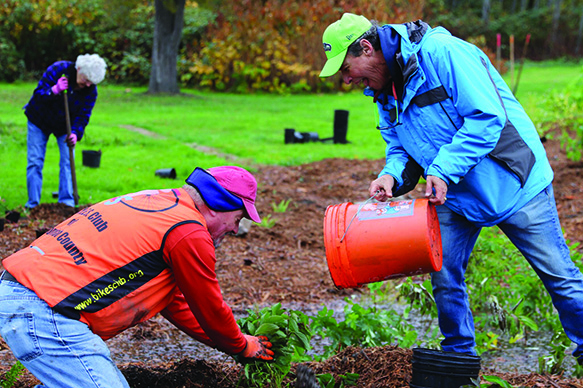
By Kalvin Valdillez, Tulalip News
“Being from Tulalip, my family always went to church here,” said Bill Topash, Tulalip Elder and St. Anne’s Roman Catholic Church member. “We have fond memories from when we were youngsters and I think it’s important to preserve this historical building. It was originally built in the 1890’s, it burned down and was rebuilt in 1905 and Catholic mass has been held here ever since.”
The white cathedral located across the street from the Tulalip Marina received a new landscape feature that will not only add to the property’s beautiful scenery, but will help address a number of issues St. Anne’s has been facing over recent years.
“We had a couple of engineering studies done about four, five years ago on the church,” Bill explained. “We found out the basement is in terrible disrepair. We were able to get some funding to get a clean crawl company to come out and clean it out, put a vapor barrier down there. But, we knew the terrible condition that the underside of the church was in, so our first significant step after the vapor barrier was trying to get the water to drain away from the church’s foundation.”
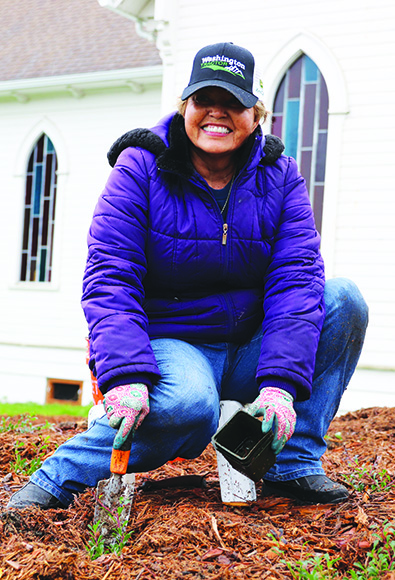
After brainstorming possible solutions, the church reached out to the Snohomish Conservation District for assistance. Upon learning about the church’s problematic flooding as well as its proximity to Tulalip Bay, the Conservation District took on the task of deterring storm water run-off and excessive water buildup away from the base of the building by constructing a rain garden on the side of the church.
A rain garden collects storm water runoff from rooftops, nearby streets, lawns and driveways, absorbing and filtering out harmful pollutants like oil, metal, paint, pesticide, fertilizer and garbage. According to the EPA, rain gardens effectively remove 90% of chemicals and 80% of sediments from storm water runoff, preventing those containments from entering our ecosystem.
“We’re really close to the bay, so pollutants that come off of roofs and paved surfaces go right into the bay,” said Derek Hann, Snohomish Conservation District Engineer. “We’re putting in a rain garden to take water from the roof of the Mission. This acts as a filter, so it does a really good job at removing all of those pollutants, it also helps with flooding issues.”
The Conservation District has worked on similar projects in the past and received funding from the Tulalip Charitable Foundation to build rain gardens. Familiar with the procedure, the Conservation District helped the church throughout process, assisting with the funding application, as well as following the Tulalip Tribes native plants and rain garden handbooks.
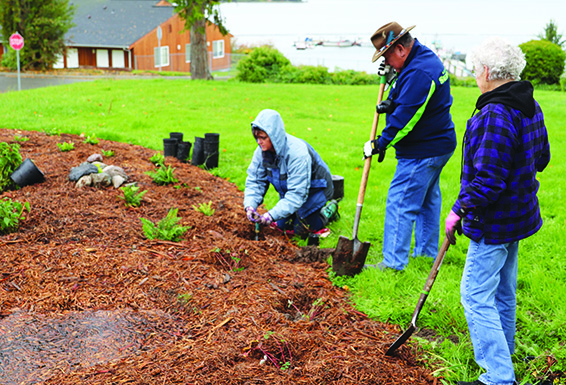
“I used the rain garden manual that was issued by the Tribal Restoration Committee, so all the plants here are native to the area and have some sort of cultural significance,” stated David Jackson, Snohomish Conservation Community Conservation Resource Specialist. “We have kinnikinnick, that’s been used traditionally for a long time by the Tribes. We also have common camas; they are a real beautiful dark purple-blue flower. We planted a lot of coastal strawberries and snowberries, those are going to attract a lot of animals to the area. The spirea and thimbleberries are going to be very good pollinators. They’re going to help biodiversity in the area. You don’t have to put much time and attention into maintaining them and you get to have community planting events and watch the garden grow over the years.”
On the morning of October 20, members of the church as well as the Snohomish Conservation District met to put the finishing touches on the garden. With a majority of the prep work done in the summertime, the crew dedicated just a couple hours to plant various native shrubs, trees and flowers in the newly established rain garden.
“We started the construction process in June and put the pipe and materials down and it’s been sitting here waiting for plants,” David said. “This is the last phase but the project will be ongoing as long as the rain garden is here. We cannot overstate how thankful and appreciative we are. The church and the Tribe worked with us through the entire construction process, all the volunteers are members of the church and of the community and it was a very special project for us.”
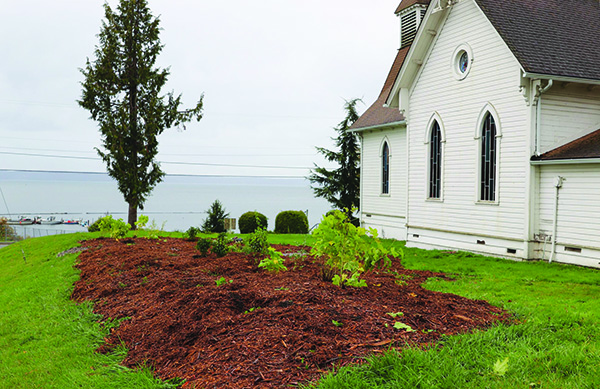
If you have any questions or you’re in need of assistance with a rain garden, David encourages you to call the Snohomish Conservation District at (425) 335-5634, stating they would be happy to help. Likewise, Bill invites you to check out the new St. Anne rain garden and learn about its function and about the native plants.
“From what I understand it is self-sustaining and low maintenance,” Bill said. “Our next goal is to have some sort of display explaining the purpose of the garden and the variety of the plants that are in there. These are all native plants. I noticed there was kinnikinnick and I said, ‘oh good, Indian tobacco.’ It’s nice to see that coming back again. We are very thankful to the Tribe, the Charitable Fund and the Snohomish Conservation District for helping us preserve our historical church. And we invite anybody to come out, everybody’s welcome.”
St. Anne’s Roman Catholic Church is now accepting donations for their annual holiday bazaar, held every Saturday from November 30 through December 23. All proceeds will go towards gifts for the homebound elders of the Tulalip community. For more information, please contact St. Anne’s at (360) 653-9400.